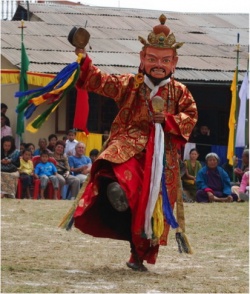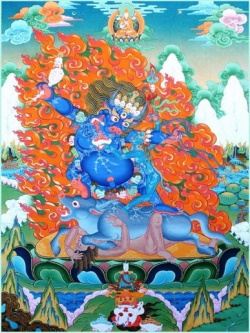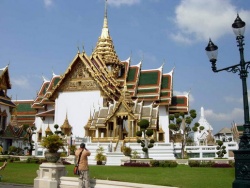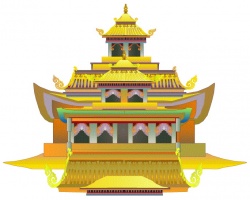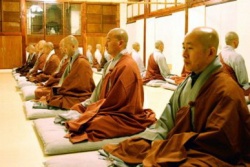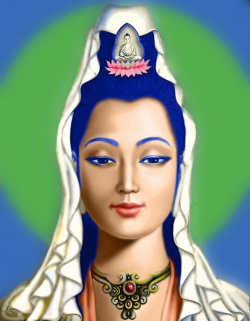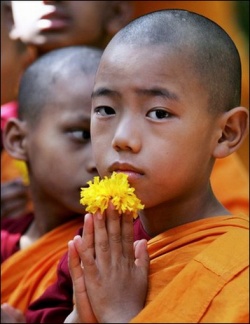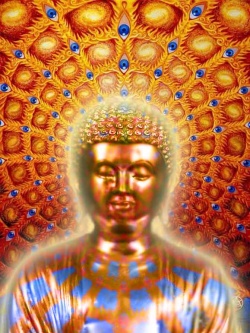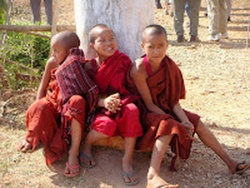Bringing the Nalanda Tradition to the West: Reflections and Challenges
Dharma Studies in the West: The FPMT Master’s Program
Since the time of the Buddha, approximately 2,500 years ago, the Buddhist teachings have been transmitted in an uninterrupted lineage, eventually reaching Tibet and flourishing there for more than 1,200 years. In recent years, as Buddhism has come to the West, there has been a steady rise in interest among Western students of Buddhism in deepening their understanding of the philosophical teachings that form the foundation of Tibetan Buddhism, as well as a wish from the side of Tibetan teachers and scholars to develop study programs to meet these needs. A number of highly respected academic institutions have programs focusing on Tibetan Buddhist religion, culture, and philosophy, but it is a fairly recent phenomenon that Western Dharma centers have attempted to develop serious, in-depth programs for the study of the great philosophical treatises of the Indian and Tibetan masters.
One of the most ambitious of these programs has been the FPMT’s Master’s Program in Buddhist Studies,[1] which was initially conceived by Lama Thubten Yeshe, and further developed and taught by Geshe Jampa Gyatso. The Master’s Program (or MP) is aimed at training both lay and ordained Western students in the classical philosophical treatises (known as the “great texts”) and the practice of the Tibetan Buddhist tradition. The program involves six to seven years of study, and is supplemented by one year of meditation in order for the students to integrate their learning and practice. I graduated from the first full-length program in 2004 and, since 2008, I have served as an online tutor for the most recent program, which just recently concluded.[2] This experience has led me to reflect at length on the challenges involved in developing advanced Buddhist study programs in the West, and I would like to share some of my thoughts on how we might begin to address these challenges.
The MP curriculum is similar to that of the Geshe programs in major Gelug Tibetan monasteries, although it is completed in a much shorter period—obtaining a Geshe degree would normally take from fifteen to twenty years in a Tibetan monastery. This difference in itself presents a huge challenge: how to condense such a vast amount of material into a program that is less than half the length of the traditional course of study. However, we should not make the mistake of assuming that those entering the program are lacking in knowledge or study skills when compared with their Tibetan counterparts: most MP students have already done many years of study before entering the program, many having earned various levels of university degrees, and thus have a wide range of knowledge of different fields, including science, humanities, business, and philosophy.
Clearly, such students may begin with little formal Buddhist knowledge, but it would be unwise to underestimate the value of the intellectual and scholarly skills they have acquired in other fields. At this juncture, when the ancient teachings of Buddhism have really begun to penetrate into the fabric of societies that are not traditionally Buddhist and interact with Western fields of thought—philosophy, cognitive science, psychology, just to begin with—we need to think seriously about how an advanced program of Buddhist studies may look in the future.
A central concern in designing and implementing such a study program is how to continue the transmission of traditional Buddhist teachings while bringing them into a modern, Western context and making them relevant to our own times and cultures, without sacrificing their essence and integrity. We need to reflect on how study of these texts can enrich understanding and practice of the Dharma, without their becoming seen as a canon that is beyond question and automatically accepted as infallible. In other words, we should not abandon the spirit of rational and scientific inquiry that forms the basis of modern Western thought, and we should seek ways to harmonize this with our study of Buddhism. This development can only occur when we approach the teachings with a balance of critical analysis and respect, having faith in the teachings without being afraid to challenge and understand them in new ways.
The Nalanda Tradition: Balancing Faith and Reasoning
His Holiness the Dalai Lama often refers to the basis of Tibetan Buddhism as the “Nalanda Tradition,” emphasizing the direct connection between the Tibetan Buddhist tradition with the work of the great scholars of Nalanda University, the ancient Indian Buddhist institution that produced some of Buddhism’s greatest scholar-practitioners, including Nagarjuna, Chandrakirti, Vasubandhu, and Dharmakirti. A central aspect of the Nalanda Tradition is an emphasis on approaching the Buddhist teachings not just through faith and devotion, but also through rigorous critical inquiry. This emphasis on intelligent investigation in Buddhism is illustrated by the analogy, often cited in Buddhist teachings, of a merchant who only buys gold after determining its quality and purity through various tests. All of the Buddha’s teachings emphasize the importance of investigating the Dharma deeply before accepting it. This critical inquiry is precisely what is being pursued in programs such as the Master’s Program.
Developing such programs is a crucial and difficult step in the transmission of the Buddha’s teachings to the West, and one of the most significant difficulties we face is how to successfully present such complex and dense material to people whose cultures, beliefs, and history are fundamentally different from those of a traditional Asian culture, such as Tibet. I have often struggled to find a balance between respect for tradition and honest critical inquiry, how to cultivate stable faith in Dharma while not giving up a healthy level of skepticism.
This process of investigation is an indispensable part of our progression towards a more awakened, more compassionate, and wiser state, the ultimate goal of Buddhist practice. However, it is not easy to skillfully balance these various facets of the spiritual path in our lives. Many Western Buddhists, especially those pursuing advanced philosophical studies, come from a perspective that is highly suspicious of orthodoxy or dogma, religious or otherwise. The past few centuries of European and American thought have, after all, elevated the status of rational inquiry far above that of religious piety. On the one hand, Buddhism appeals to this rationality by deeply challenging engrained ideas about success, happiness, material wealth, and even mainstream religion. On the other hand, when we study Buddhism with traditionally trained Tibetan teachers, we often find that the teachings are intertwined with a wide range of cultural assumptions, which do not always fit neatly or comfortably with a strictly rational perspective.
It is useful to look briefly at how Buddhist philosophy has traditionally been studied by Tibetans, and to consider how this contrasts with Western educational methodologies.[3] (I am mainly referring here to the Gelug tradition, which places strong emphasis on scholastic understanding as a basis for spiritual realization.) Historically, in Tibetan culture the study of high-level Buddhist philosophy has been almost exclusively the domain of monks. The Tibetan monastic approach involves many years of memorization, study, and debate of texts that are complex and multi-layered, sometimes incomprehensible without explanations of highly trained masters. The students learn the art of debate from a young age, methodically analyzing a wide range of subjects, beginning with simple phenomena such as colors and shapes and moving on to more complex topics, such as divisions of the mind, advanced logic, and so forth. The debate format is tightly structured and follows strict rules, requiring students to thoroughly memorize the texts and to internalize the rules of debate to the point of their becoming virtually automatic. Without memorizing the texts, it is impossible to get far in a debate.
There is no room for guessing or speculation; the respondent must be able to reply with absolute precision, based on what is stated in the text. As their studies progress, they apply their analysis to increasingly subtle topics, such as the four noble truths, emptiness, dependent arising, and the paths to liberation and enlightenment. After gaining a solid foundation in logic, debate, and the overall Buddhist worldview, those seeking to attain the degree of Geshe (a Buddhist monastic academic degree) spend many years studying subjects such as the Perfection of Wisdom (Prajnaparamita), Middle Way (Madhyamaka), valid cognition (Pramana), ethical discipline (Vinaya), and manifest knowledge (Abhidharma). Monks (and now nuns) can obtain one of several types of Geshe degree, the highest level being Geshe Lharampa. Although this approach is most emphasized in the Gelug tradition, the different Tibetan traditions offer variants of the Geshe degree. The deep understanding that one gains from these many years of study and debate becomes the basis for the transformational wisdom that one may later gain from deeper meditation on these subjects.
The curriculum of the Master’s Program as it is presently structured includes three of these five “great texts” and their Tibetan commentaries—Maitreya’s Ornament for Clear Realization (Abhisamayalamkara), Chandrakirti’s Supplement to the “Middle Way” (Madhyamakavatara), and Vasubandhu’s Treasury of Manifest Knowledge (Abhidharmakosha)—as well as the “grounds and paths” of tantra and the Guhyasamaja Tantra (which are normally studied only in specialized tantric universities). Supplementary subjects such as mind and awareness, philosophical tenets, or reviews of the main topics are sometimes taught if time allows. Students take regular exams, and at the end of the program, they review and are examined on all five subjects. In order to receive a completion certificate, they are also required to do one year of retreat, which allows them to integrate the material more deeply. Parallel to the residential course is an online course, with students around the world studying via an e-learning environment, with recorded review lectures, quizzes and exams, and online discussion.
Given the much shorter length of the Master’s Program compared to traditional geshe studies, the MP clearly does not aim to produce “Western geshes,” but to give Western students a complete education in Buddhist studies. However, this format is not without its shortcomings. While students in such a program receive an enormous amount of teachings, and thus a good basis for deepening their studies and practice, relatively little time is dedicated to a deep analysis of the teachings, and formal debate is virtually absent. There are numerous reasons for this, one of the principal ones being the difficulty of translating the highly formalized Tibetan debate method, so deeply based on rote memorization, into a Western context where students have little familiarity with memorization as a learning tool. With this lack of debate, the teachers and tutors of such a program are forced to come up with effective tools for helping students not only to learn, but to master such dense, difficult material. So far, this has been one of the greatest challenges of this program.
I have had the great fortune to study these texts with highly qualified teachers, including my principal teacher Geshe Jampa Gyatso, who helped me to understand that Dharma is not just about knowledge obtained from study, but the skillful integration of this knowledge into our experience, and the transformation of our very way of being. As a tutor for such a program, I have found myself trying to explain Buddhist texts that are often centuries old, with multiple layers of meaning and complex terminology, to students whose culture and worldview differs radically from that which informs these texts. These texts are often obscure and difficult to understand, even for the most erudite lamas and scholars.
A Western tutor working with this material may feel obligated to be faithful and respectful to the tradition, on one hand, and wish to make the teachings relevant to students’ lives and spiritual development, on the other—not an easy task. With more general subjects such as the Stages of the Path (lam rim), this is already challenging, but many lam rim subjects are self-explanatory and one has some flexibility in how to present the topics, choosing to emphasize some more than others, offering different interpretations, and so forth. However, with texts as complex as the Abhisamayalamkara or Abhidharmakosha, just to understand the basic meanings of the texts requires extensive study and reflection, and understanding their relevance to practice means taking a huge leap beyond that.
Difficulties for Western Students: Challenging Orthodoxy
Western students of Tibetan Buddhism must wrestle with apparent contradictions between the worldview and didactic methods in our own culture and those that we encounter in traditional Asian Buddhist teachings. The cornerstone of a modern Western education is critical examination of facts from varying points of view, without automatically privileging any one of these points of view as absolutely true. We are taught to value originality and to explore ideas that innovate and challenge orthodoxy. In traditional Buddhist teachings, on the other hand, innovation is often regarded with deep suspicion, and even discouraged. Although we are encouraged to rigorously analyze the teachings before accepting them, this analysis takes place almost entirely within the accepted parameters of the Buddhist worldview, and those propounding new interpretations of the Dharma may be viewed as pariahs, whose straying from accepted explanations might somehow contaminate the teachings—even Tsongkhapa was heavily challenged and criticized for his sometimes radical interpretations of Buddhist teachings.
Despite the strong emphasis on reasoning, it is difficult to escape the weight that the authority of tradition and scripture carries for traditional Buddhists. There are unspoken, but evident, taboos in not accepting certain teachings as infallible truths. Thus we see that when His Holiness the Dalai Lama questions the validity of Abhidharma cosmology or downplays certain aspects of traditional teachings, there is no hesitation in following his lead. However, if a less authoritative teacher or (heaven forbid) a Westerner challenges orthodoxy in the same way, it may even be seen as a degeneration of the purity of the lineage, when in fact such a person is simply following the Buddha’s advice to closely examine the teachings.
This can create a sense that one cannot ask honest, critical questions without being judged or criticized; one may begin to feel that one is not a “good Buddhist” if one asks too many questions. We find ourselves in a quandary: our initial sense of skepticism and curiosity, which led us to the apparent tolerance and openness of the Buddhist tradition, now comes to be seen as risky, or even dangerous. However, if we are to develop into mature practitioners of the Buddha’s teachings, we must ask some difficult questions. We may even need to ask what it really means to be “Buddhist.”[4] It would be unusual for Tibetans to question whether or not they are Buddhist—Buddhism is a culture and tradition they are born into and which they, for the most part, readily accept. For Westerners, more investigation is required when one decides to actively engage with Buddhism as a practice and view.
Dharma in the Modern World: Developing New Tools
Let us consider the idea of “transmission” of the Dharma—the Buddha’s teachings—and what that entails. Traditionally, the Buddha’s teachings are divided into the Dharma of scriptures—the texts containing the teachings and commentaries of the Buddha and the lineage masters—and the Dharma of realizations—the internalization of the meanings in these texts, resulting in the final goal: liberation or enlightenment. In reality, these two are intimately related, and both are necessary in order for the Dharma to be effectively and completely transmitted from one culture to another. The transmission of Dharma depends on maintaining an “uninterrupted lineage” of the canonical texts, teachings, and commentaries from qualified masters to their disciples, but just continuing the scriptural transmission is not sufficient, even if done with great faith and diligence, if we do not also transmit the transformative aspect of the teachings, the realizations. A complete transmission of the Dharma is contingent on the development of skillful methods that enable the transmission of these teachings to different cultures, and thus a certain amount of adaptation is unavoidable.
This has been the case everywhere that the Dharma has traveled from one culture to another: from India to Tibet, China, Korea, Burma, and other countries that became Buddhist. Now Buddhism has come to the West, in a period in which technological advances have rapidly sped up the availability and exchange of information. Those involved in this exchange must adapt to this reality and utilize a variety of methods in this transmission, not just traditional ones. If we simply mimic the traditional methods of Buddhist study and education without adapting them to their new context, we may well see these sublime teachings, which show us how to develop the greatest human potential, becoming little more than quaint, but largely irrelevant, cultural relics. One of the greatest challenges we face in this process is how to relate Buddhist scholastic practice to the practical, realized aspects of Dharma: cultivation of positive inner qualities such as mindfulness, mental stability, compassion, and wisdom. In Buddhist terms, we need to approach this process with a balance of skillful methods and penetrating wisdom, integrating the insights of the Buddhist tradition with the best of Western pedagogical methods and technology.
When studying the great philosophical texts of Buddhism in a traditional way, students would first memorize the “root text,” and then receive a transmission and detailed commentary on the entire text from start to finish, slowly bringing out the deeper meaning through extensive debate, as mentioned earlier. Without the process of internalization and mastery that occurs through debate, it is difficult for students to identify the essential points in a text that may consist of literally hundreds of lists, definitions, and conflicting assertions from various philosophical points of view. When studying such texts without training in debate, Western students encounter many difficulties in knowing how to “take the essence” of these teachings, and how to put them into practice.
It would be easy to suggest that Western students should simply learn how to debate like Tibetans, but the traditional reliance on memorization brings up many difficulties. We have a strong tendency to suspect or even reject anything resembling dogma or absolutist religious authority. Rote memorization has long been rejected in Western education in favor of developing skills of critical thinking and analysis; originality of thought, rather than repetition of doctrine, is one of the prime objectives of modern education. While a traditionally educated Tibetan student would not have much difficulty accepting that something is true simply because it was stated by the Buddha, Nagarjuna, or Tsongkhapa, a Western-educated student might strongly question the notion of the author’s infallibility. This is not to say that memorization should be rejected outright—it can indeed a very valuable tool for sharpening one’s mental faculties, among other things—but it needs to be supplemented with learning methodologies more familiar to Western students, where one would consider a broader range of viewpoints, even from other traditions or disciplines. We should make use of the many tools we have, not just dismiss them as irrelevant to the study of Buddhism.
We must also remember that while Tibetan monastics often begin their religious studies as children, Western students in programs such as the Master’s Program have already acquired a great deal of knowledge and experience, both through higher education and professional careers. Despite this, it seems that when we approach traditional Dharma studies, we often feel compelled to reject large parts of our “secular” learning, rather than building on it and integrating it with our understanding of Dharma. This only serves to strengthen a false dichotomy between “worldly” knowledge—literature, art, science, philosophy, mathematics, etc.—and “Dharma knowledge,” which concerns questions that somehow transcend this world. I often get the impression that Western Buddhists feel they must ignore the great intellectual, artistic, and spiritual innovations of their own culture—whether they come from Einstein, Jesus, Shakespeare, Picasso, or John Coltrane—in order to be serious Buddhists, rather than appreciating how the insights of great minds, regardless of their culture or religious beliefs, may help to cultivate a broader, deeper understanding of Dharma.
Rigidly adhering to such an artificial split contradicts the exemplary openness shown by the Dalai Lama, who has consistently pioneered and encouraged cross-cultural and interdisciplinary dialogues, such as the Mind and Life conferences, and the introduction of scientific education into Tibetan monasteries. He has even appointed an American monk as the abbot of a Tibetan monastery.[5] We would do well to learn from the example of His Holiness, who consistently shows himself to be an innovator in the best sense of the word, as well as being an undisputed master of the subtlest points of Buddhist philosophy and practice and a living example of compassion, kindness, and deep insight. Lama Thubten Yeshe was also a proponent of integrating modern knowledge with Buddhist wisdom: “Today, scientific technology has discovered many things that human beings cannot touch—energy, for example. This development of scientific higher consciousness is beautiful; we can carry it into our meditation. When people who study and practice Dharma examine developments in scientific technology, they can find extraordinary examples that they can use. This understanding of reality is very important.”[6]
Conclusions: The Road Ahead
What can we conclude from all of this? Are we looking at the inevitable degeneration of the Tibetan Buddhist tradition, in favor of a dumbed-down Buddhism ready for easy consumption by a public wanting everything to be downloadable as a smartphone app? Not at all. We are looking at an evolution of Buddhism in the West, just as it has evolved in its transmission from India to many other cultures, including Tibet. In order for the Dharma to continue to thrive, and for Dharma education to develop in the West, a few fundamental ingredients are necessary: first, willingness to experiment with the format, and not being obstinately attached to an exclusively traditional approach; second, a clear understanding of the goal of such education: a combination of scholastic depth and experiential application; and third, an approach that builds bridges between the wisdom of Buddhism and of our own cultures, such as science, the humanities, and philosophy, rather than seeing them as contradictory. All of this, of course, needs to be carried out in a way that is balanced and respectful, by teachers who understand the teachings well and have made serious effort to internalize and realize their meanings. My hope is that we will see in the future a proliferation of aspiring bodhisattvas who are able to integrate their intellectual and experiential understanding of the great spiritual insights of the Buddha and the great Indian and Tibetan masters with the thought of Plato and Wittgenstein, quantum theory, neuroscientific research, and expressions of Dharma in literature, art, and poetry, all for the greatest benefit of infinite sentient beings. Why not?
Patrick Lambelet
Tutor for the online FPMT Master’s Program
Pomaia, Italy
© Patrick Lambelet
March 23, 2014
Footnotes
[1] Despite being called “Master’s Program,” this program is presently not formally accredited by any university and does not lead to an MA, or Master’s degree.
[2] There was an earlier version of the program, before 1998, but it was not as comprehensive, with regular examinations and certification.
[3] Georges Dreyfus’ book, The Sound of Two Hands Clapping, is an excellent resource for this subject, combining academic research on Tibetan monastic education with reflections drawn from his own experience as a Western Buddhist monk (Dreyfus was the first Westerner to obtain the Geshe Lharampa degree).
[4] Interestingly, the Tibetan word translated as “Buddhist” (nang pa) literally means “insider,” or “practitioner of the inner tradition.” It thus has a broader sense than simply being a follower of the Buddha, unlike, for example, the term “Christian.”
[5]In 2012, His Holiness appointed American monk Nicholas Vreeland as the abbot of Rato Monastery, in India, telling him, “Your special duty is to bridge Tibetan tradition and the Western world.” See Tricycle article (www.tricycle.com), Fall 2012.
[6] Lama Thubten Yeshe, Becoming the Compassion Buddha (2003, Wisdom Publications), p. 44.

